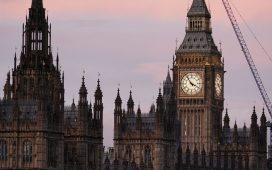If there is one thing that this chaotic election has not been short of, it’s hyperbole.
From the “most important election in a generation” to “a battle for Britain’s soul”, UK media outlets from across the political spectrum have bombarded voters with excited rhetoric in the run-up to one of the most unpredictable elections in recent history.
Although many pundits initially predicted a thumping Conservative majority, latest polls show that Boris Johnson’s hold on power may be under threat as polling day arrives. Here are the four most likely election outcomes.
Landslide Conservative majority
Johnson could win a landmark victory by “winning over traditional Labour voters in small cities and big towns in Wales, the Midlands and the north of England, while holding steady in Scotland, London and the south of England generally”, The Guardian says.
The Labour Party would probably bear the brunt of the losses, making it “difficult for Jeremy Corbyn to hang on as leader – while Johnson would have a free rein to complete Brexit at the third time of asking by 31 January”, the newspaper continues.
In this scenario, “we could see votes on Brexit beginning even before the new year, but certainly by the first couple of weeks of January”, says The Telegraph.
“Theoretically the UK could even leave the European Union early, on 1 January,” adds The Times.
Narrow Conservative majority
If Johnson achieves a narrow majority, the prime minister should still be able to get his Brexit deal through the Commons but it “could be harder if Brexiteers in his party demand changes to the bill”, The Times says.
“However, a majority of any kind would be considered a triumph for Mr Johnson and MPs may be reluctant to rock the boat so quickly after a victory,” the paper notes.
The size of his majority will also dictate the Tory leader’s picks for cabinet roles. “With a strong majority, he may feel that he can relegate some of his main rivals, such as Michael Gove, to the backbenches,” says The Telegraph. “With a slimmer majority, it is less likely Mr Johnson will want to promote dissent on the backbenches.”
–––––––––––––––––––––––––––––––
For a round-up of the most important stories from around the world – and a concise, refreshing and balanced take on the week’s news agenda – try The Week magazine. Start your trial subscription today
–––––––––––––––––––––––––––––––
Conservative minority government with DUP
If the Conservatives fail to win a majority but remains the largest party, Johnson will either be forced to resign or try to form a minority government.
The Liberal Democrats have ruled out entering into a coalition with the Conservatives, so the Tories may once again need to turn to the Democratic Unionist Party (DUP). The Northern Irish party entered into a “confidence and supply” agreement with the Tories in 2017 after Theresa May lost her majority.
Another such agreement could threaten Johnson’s Brexit deal, however, with the DUP vehemently opposing his plan to set Northern Ireland apart from the UK when it comes to customs and other EU rules.
Labour and SNP/Lib Dem coalition government
If the Conservatives can’t form a minority government, Labour will get a chance to do so.
The Times notes that if Labour is the largest party but falls shy of a majority, they “could do a deal with either the Lib Dems or the Scottish National Party (SNP)”, both of whom would “demand an immediate second referendum” on the EU.
“However, the government would probably not last long as neither party would back [Corbyn’s] radical domestic agenda in the long term,” the paper adds.
Many pollsters believe that this election outcome is unlikely – but admit surprises could be ahead.
As Irish broadcaster RTE notes, young voters are the “most Europhile and left-wing in Britain yet also the least likely to vote, representing an unknown factor in Thursday’s battle for Downing Street”.














